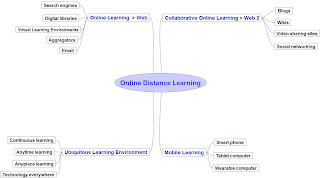Technology has
successfully been used in professional development and corporate training. Blocker (2005)
has explained that web based training “provides an opportunity to address many
known business issues, such as cost reduction, access to information, learning
accountability, and increased employee competence” (as cited in Pang, 2009, p.
2).
Key technologies CMS WEB 2.0
Technologies that can be used to deliver learning experiences include course management systems (CMS), also known as learning management systems (LMS), and Web 2.0 tools such as blogs, wikis, podcasts (“also called vlogs if they use video, or audioblogs if only audio is used”) (Beldarrain, 2006, p. 140) and virtual worlds (Simonson, Smaldino, Albright, & Zvacek, 2012). Pang (2009) has suggested that a multimedia environment that incorporates interactive video is particularly important in the delivery of effective web-based professional development programs.
Let us consider the following scenario: Employee safety training program
In an effort to improve its poor safety record, a biodiesel manufacturing plant needs a series of safety training modules. These stand-alone modules must illustrate best practices on how to safely operate the many pieces of heavy machinery on the plant floor. The modules should involve step-by-step processes and the method of delivery needs to be available to all shifts at the plant. As well, the shift supervisors want to be sure the employees are engaged and can demonstrate their learning from the modules.
In an effort to improve its poor safety record, a biodiesel manufacturing plant needs a series of safety training modules. These stand-alone modules must illustrate best practices on how to safely operate the many pieces of heavy machinery on the plant floor. The modules should involve step-by-step processes and the method of delivery needs to be available to all shifts at the plant. As well, the shift supervisors want to be sure the employees are engaged and can demonstrate their learning from the modules.
An ideal training program for the above scenario could include the
following:
- Computer kiosks installed at strategic locations throughout the manufacturing plant for use by employees to access asynchronous, self paced, interactive video supported course modules (learning objects) incorporating simulations of real world safety risk scenarios.
- Measuring the success and effectiveness of the training, based on Kirkpatrick's (Simonson, 2007) four levels of evaluation: Level 1 measures learner reactions to the training; Level 2 measures knowledge acquisition; Level 3 measures application of knowledge; Level 4 measures overal success of the training program; Level 5 (new level) measures Return on Investment.
- Post training employee performance evaluations linked to promotions and bonuses.
Practical examples of asynchronous training programs
-
Airlines such as British Airways (45 000 employees), Southwest Airlines (35 000 employees) and Delta Airlines (60 000 employees) have used asynchronous refresher courses for their geographically dispersed workforce (Koller, Harvey & Magnotta, 2005).
- Koller, Harvey & Magnotta (2005) have also cited a remarkable user of asynchronous training programs, Home Depot, the world’s largest home improvement retailer with more than “300 000 employees, 1 731 stores nation-wide and abroad, and over 30 000 products for sale” (p. 25). 60 000 new cashiers were hired in 2004. The demand for technology based training at Home Depot is enormous.
References
Beldarrain, Y. ( 2006). Distance Education Trends: Integrating new technologies to foster student interaction and collaboration. Distance Education, 27(2). 139-153. Retrieved from Education Research Complete.
Khan, S. (2011).
Salman Khan talk at TED 2011. Video. Retrieved from
http://www.khanacademy.org/
Koller, V. Harvey U.S.
Retrieved
from http://www.doleta.gov/reports/papers/tbl_paper_final.pdf
Pang, K. (2009). Video-Driven Multimedia, Web-Based Training in the
Corporate Sector: Pedagogical Equivalence and Component Effectiveness.The International Review of Research in Open and Distance Learning, 10(3).
Polsani, R. (2003). Use and Abuse of Reusable Learning Objects. Journal of
Digital Information, 3(4). Retrieved
from
http://journals.tdl.org/jodi/index.php/jodi/article/viewArticle/89/88
Simonson,
M., Smaldino, S., Albright, M., & Zvacek, S. (2012). Teaching and learning at a distance: Foundations of
distance education (5th ed.) Boston ,
MA
Simonson, M. (2007). Evaluation and distance
education: Five steps. Quarterly Review of Distance Education. 8(3), 191–194.
Web sites visited:

